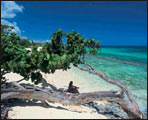Holguín Geography
Province located in the northeast portion of Cuba’s eastern region with coasts to the Atlantic Ocean. It has an extension of 9 282,95 sq km (3584 sq mi) and a population of 1 011 761 inhabitants (1996). The province ranks fourth in extension and third in population.
This province is limited by the heights of maniabón, the plains of Cauto and Nipe, and the mountains of Nipe-Sagua-Baracoa, being the Cristal peak its maximum height with 1231 m (4038 ft).
 Its hydrography is represented by rivers Mayarí, Gibara, Sagua de Tánamo, Tacajó, and the dams Gibara, Cacoyugüín, and Sabanilla. Its littoral strip possesses numerous bays, being Gibara, Banes, and Nipe the most important.
Its hydrography is represented by rivers Mayarí, Gibara, Sagua de Tánamo, Tacajó, and the dams Gibara, Cacoyugüín, and Sabanilla. Its littoral strip possesses numerous bays, being Gibara, Banes, and Nipe the most important.
Its economic geography is characterized by agriculture and cattle raising. There is also sugarcane and other crops, and industry is represented by sugarcane processing, nickel mining and processing, and sideromechanical industry.



